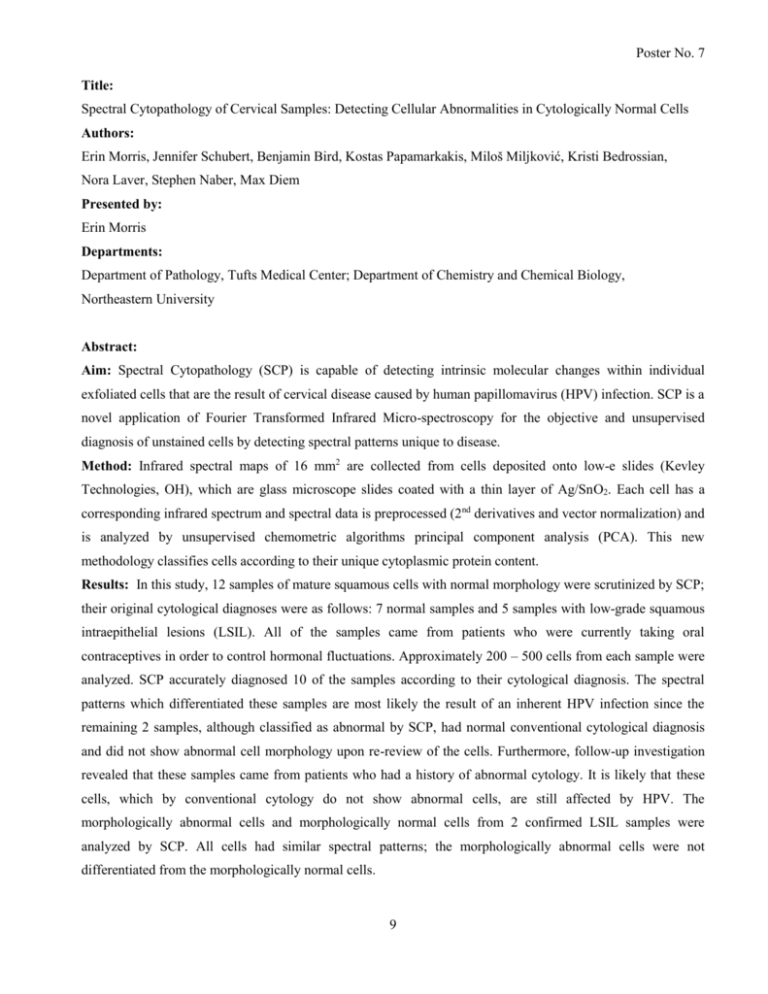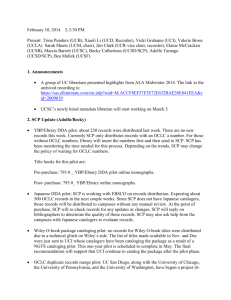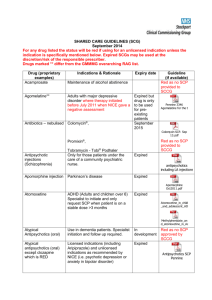Spectral Cytopathology of Cervical Samples: Detecting Cellular
advertisement

Poster No. 7 Title: Spectral Cytopathology of Cervical Samples: Detecting Cellular Abnormalities in Cytologically Normal Cells Authors: Erin Morris, Jennifer Schubert, Benjamin Bird, Kostas Papamarkakis, Miloš Miljković, Kristi Bedrossian, Nora Laver, Stephen Naber, Max Diem Presented by: Erin Morris Departments: Department of Pathology, Tufts Medical Center; Department of Chemistry and Chemical Biology, Northeastern University Abstract: Aim: Spectral Cytopathology (SCP) is capable of detecting intrinsic molecular changes within individual exfoliated cells that are the result of cervical disease caused by human papillomavirus (HPV) infection. SCP is a novel application of Fourier Transformed Infrared Micro-spectroscopy for the objective and unsupervised diagnosis of unstained cells by detecting spectral patterns unique to disease. Method: Infrared spectral maps of 16 mm2 are collected from cells deposited onto low-e slides (Kevley Technologies, OH), which are glass microscope slides coated with a thin layer of Ag/SnO2. Each cell has a corresponding infrared spectrum and spectral data is preprocessed (2nd derivatives and vector normalization) and is analyzed by unsupervised chemometric algorithms principal component analysis (PCA). This new methodology classifies cells according to their unique cytoplasmic protein content. Results: In this study, 12 samples of mature squamous cells with normal morphology were scrutinized by SCP; their original cytological diagnoses were as follows: 7 normal samples and 5 samples with low-grade squamous intraepithelial lesions (LSIL). All of the samples came from patients who were currently taking oral contraceptives in order to control hormonal fluctuations. Approximately 200 – 500 cells from each sample were analyzed. SCP accurately diagnosed 10 of the samples according to their cytological diagnosis. The spectral patterns which differentiated these samples are most likely the result of an inherent HPV infection since the remaining 2 samples, although classified as abnormal by SCP, had normal conventional cytological diagnosis and did not show abnormal cell morphology upon re-review of the cells. Furthermore, follow-up investigation revealed that these samples came from patients who had a history of abnormal cytology. It is likely that these cells, which by conventional cytology do not show abnormal cells, are still affected by HPV. The morphologically abnormal cells and morphologically normal cells from 2 confirmed LSIL samples were analyzed by SCP. All cells had similar spectral patterns; the morphologically abnormal cells were not differentiated from the morphologically normal cells. 9 Poster No. 7 Conclusion: SCP tracks consistent chemical variations in cells which are being transformed by disease states. Therefore, SCP does not depend on identifying the few morphologically abnormal cells within a large sample in order to make an accurate diagnosis, as traditional cytology requires. These results indicate that the biochemical analysis provided by SCP is a more sensitive diagnostic tool for HPV screening in gynecological cytology and can potentially be used in prevention of disease. 10











